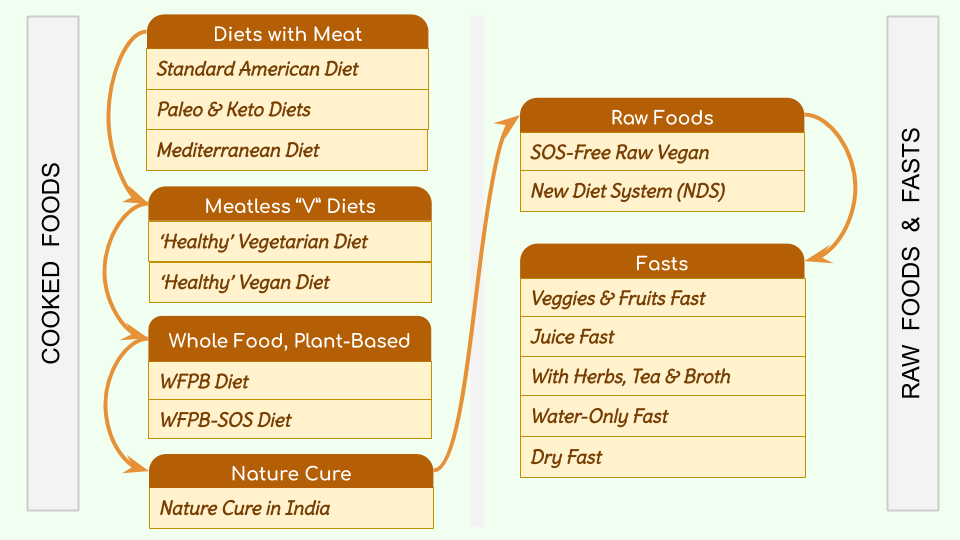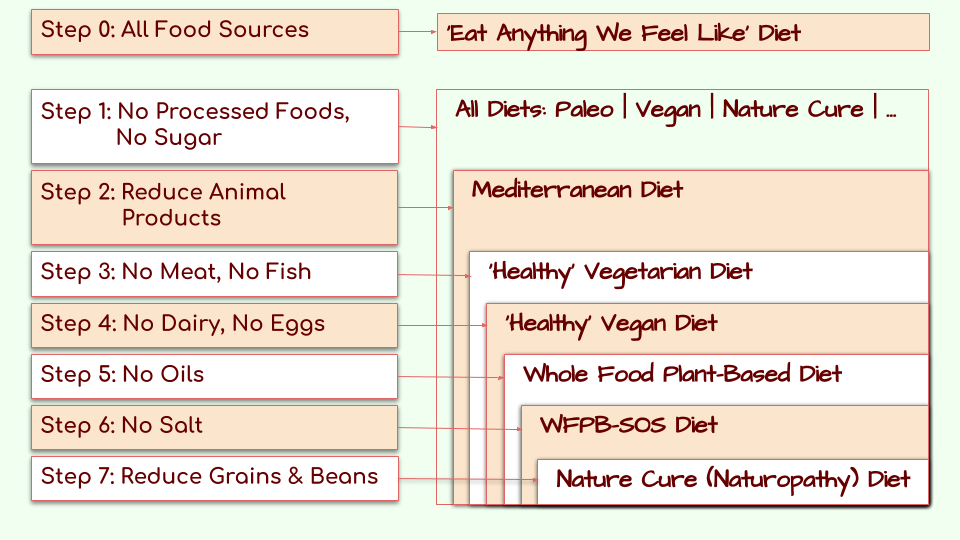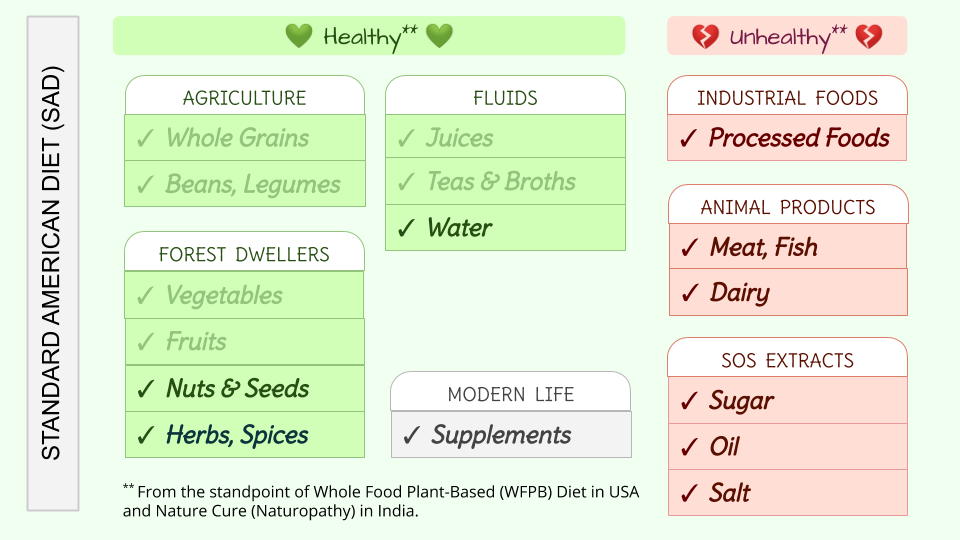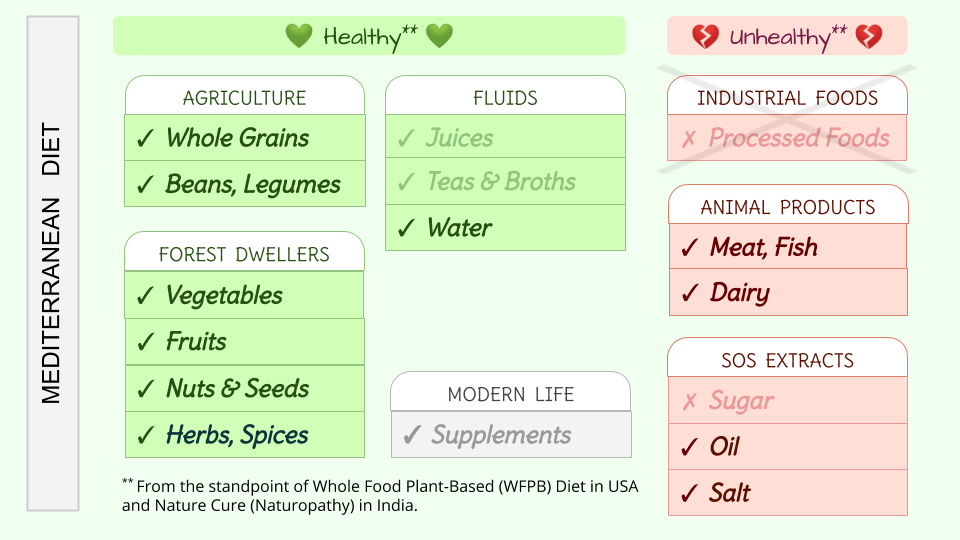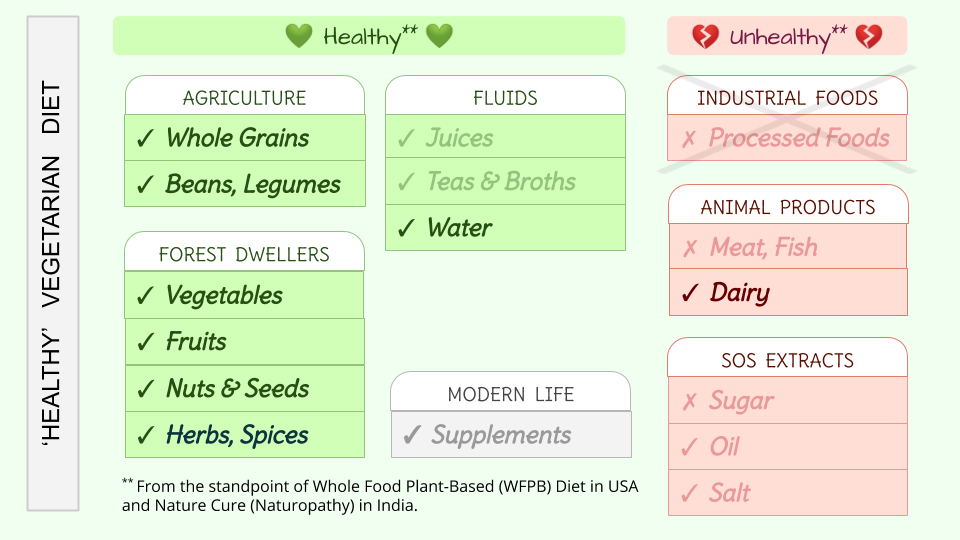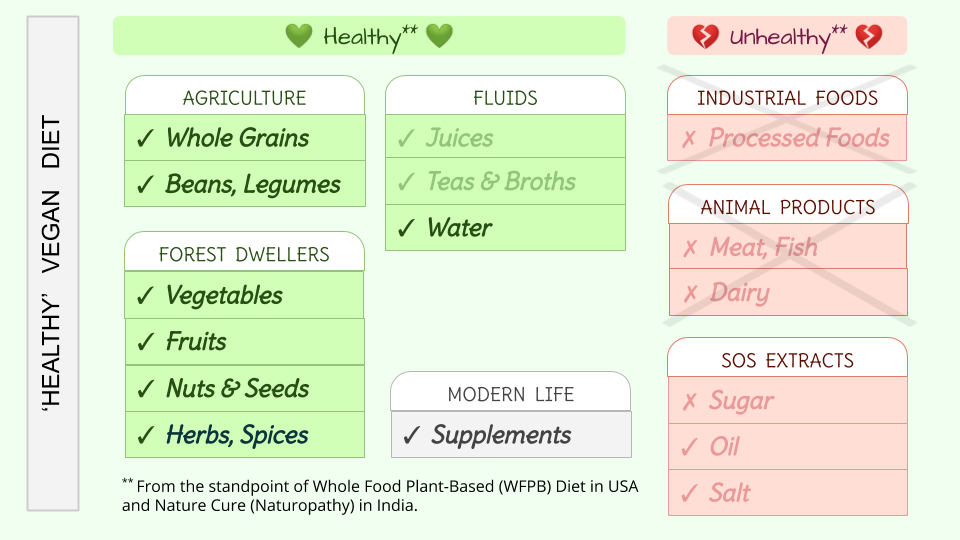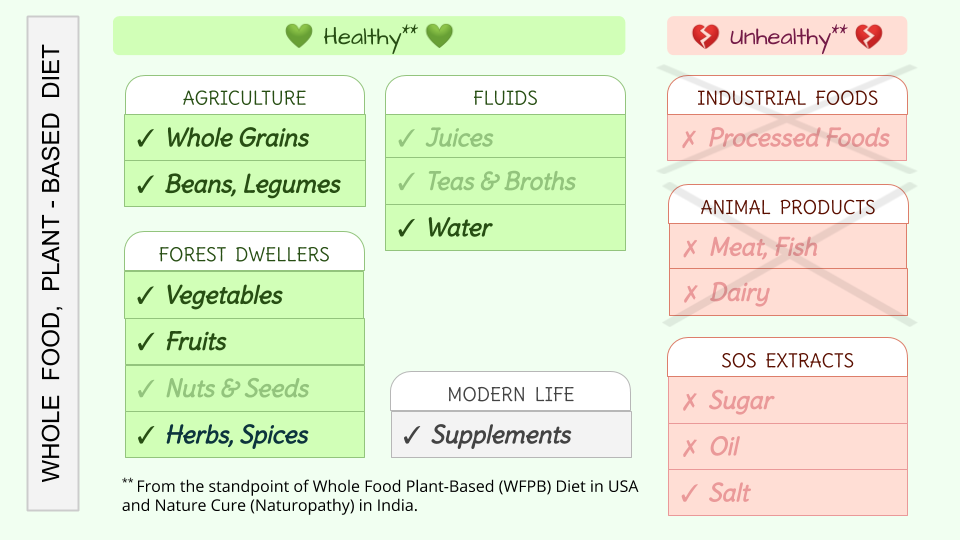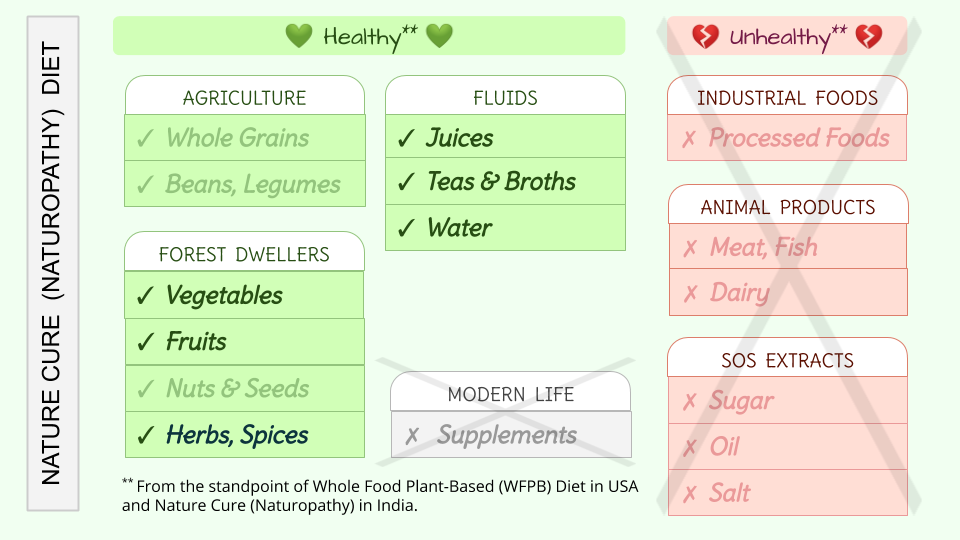In this article, I present the big picture of a few different diets as I understand them. All diets in this article allow cooked foods. Part 2: Raw Foods and Fasting Protocols explores the world of diets and fasts with uncooked foods.
After having experimented with a few different food systems, I have fallen in love with two of them:
- Whole Food, Plant-Based (WFPB) Diet: Developed in USA after several decades of nutrition research. WFPB guidelines are not well known to the general public but awareness is on the rise. I follow a more difficult version of WFPB called WFPB-SOS or WFPB SOS-Free, where SOS denotes Salt, Oil and Sugar.
-
Nature Cure (Naturopathy): In India, Nature Cure practitioners traces its origins to ancient Indian traditions. It's the food system of forest dwellers who strive to live in harmony with nature without harming other sentient beings. Over the ages, Nature Cure traditions have been kept alive by those who live in forests to pursue spiritual growth and meditation. I like the variant of Nature Cure (Naturopathy) focused on raw foods and fasting protocols (juice-only, water-only and even dry-fasting).
WFPB Diets and Nature Cure (Naturopathy) Diets emanate from two different traditions. Yet they have so much in common! I find that fascinating :)
I like to visualize various diets and fasting protocols as a sequence of eliminations. The first 7 steps of elimination look like this:
The next 7 steps of the Sequence of Elimination are discussed in Part 2: Raw Foods and Fasting Protocols.
Let's take a holistic look at Steps 1-7 and Steps 8-14 combined. At one extreme is 'Eat Anything We Feel Like' Diet in which all food sources are included. At the other extreme is Dry Fasting in which all food sources are excluded!
How does the Sequence of Elimination help me? The sequence has given me some insights. For example, I have a better idea of matters like, 'which of these food eliminations and fasts require medical supervision?'. It also helps me make a judgment call like, 'Looks like I'm not being able to follow System X, so what is the smallest change that I could introduce so that I don't deviate too far away from system X'. For details, see
We can understand the relationships between different diets covered by Steps 1-7 in terms of food sources below:
In total, we have 7 food categories and 16 food sources. For an in-depth discussion, see
Healthy vs Unhealthy: Food categories have been labeled as 'Healthy' and 'Unhealthy'. Both labels are from the perspective of Whole Food, Plant-Based (WFPB) Diet and Nature Cure (Naturopathy) Diet — the two diets I am fond of.
How many people in the world would agree with the labels Healthy and Unhealthy above? Luckily, there is widespread agreement that Processed Foods should be labeled Unhealthy. But very very few people will agree that all Animal Products (Meat, Fish, Dairy) are unhealthy. Even fewer will agree that all three SOS extracts (Sugar, Oil, Salt) are unhealthy, and that our daily meals should be Sugar-free, Oil-free and Salt-free! For most people, a food system without Meat, Fish, Dairy, Salt, Oil, Sugar would be unthinkable, even preposterous!
Why are Supplements in Grey? Because WFPB and Nature Cure (Naturopathy) guidelines don't agree on Supplements. For discussion, see the section titled 'Mimicking the Ancients in a Modern World' in this article: Pre-Agriculture, Agriculture and Modern Food Sources.
Pre-Agriculture vs Modern Food Sources: A couple of diets mimic our ancestors. The Paleo Diet aims to adopt the food habits of hunter-gatherers from pre-agriculture era. In popular culture, the Paleo Diet is believed to be a diet with a large percentage of animal products. However, WFPB doctors and archaeological geneticist argue that the Paleolithic were actually plant-based! In India, we have a raw food system called New Diet System which aims to mimic the forest dwellers from the past who consumed only vegetables, fruits, nuts and seeds. But we must keep in mind that modern foods (both animal sources and plant sources) are not the same as the foods that our ancestors consumed. For an in-depth discussion, see
In USA, if we follow the 'Eat Whatever We Feel Like' approach to Diet, we don't naturally gravitate towards vegetables, fruits, beans and grains. For a variety of reasons, many of us gravitate towards highly processed animal products typified by pizzas, sugary drinks, steaks, hamburgers, ice creams, cookies, cakes, and so on. Such food choices are unfortunate. In USA, some people use a pejorative term SAD (Standard American Diet) for such a food system. Personally, I don't like this term but it's popular in healthy eating articles. Some speakers say that Standard American Diet leads to Standard American Diseases (more SAD) and Standard American Deaths (even more SAD).
Infographics showcasing alarming rates of serious diseases associated with Standard American Diet abound on the Internet. Instead of focusing on such morbid statistics, let's focus on questions like these:
I have come to understand that our bodies are awesome healing systems. If our body is diseased, then in many cases, we can experience a major reduction in symptoms (and in many cases, complete reversal of symptoms) by (a) stopping the influx of unhealthy foods and (b) boosting the intake of healthy foods. It's as simple as that! But which foods are healthy? Which ones are unhealthy? Let's see.
The term 'Processed Foods' is difficult to define. Why? Because in the modern world, we have dozens (maybe hundreds) of processing techniques for hundreds of food ingredients and thousands of mixtures. So we have to dig into details. For an in-depth discussion, please see:
Starting with an 'Eat Anything That We Feel Like' Diet, if we eliminate Processed Foods but retain other aspects of Standard American Diet, we start discovering a series of meat-dominant diets like Paleo, Keto and Mediterranean Diet. Here is an overview:
All diets remove Processed Foods! To me, it appears that all diets in the world fall into two large clusters: paleo (meat-dominant) and vegan (plant-only). Both clusters are in harmony when it comes to Step 1 (Eliminate Processed Foods)! They both agree that Processed Foods should be eliminated.
Step 1 is the most important Step! It should never become our blind spot: we shouldn't skip it. When I meet somebody who has only recently started learning about nutrition and its relationship to diseases, I encourage them to focus on Step 1. It is a difficult step and requires a lot of conscious effort. First, we have to understand what 'Processed Foods' really means (it is a confusing term; please see What are Processed Foods?). Then we have to tackle a series of challenges. For example, certain food addictions have to be overcome — please browse through What is Driving the Obesity Epidemic? and Food Addictions to grasp what we are up against! And we have figure out how to do groceries, how to prepare foods differently, how to socialize with friends, what to eat on special occasions, and so on. All of these are difficult tasks but they bear fruit.
Step 2 is commonly advocated by nutritionists in the West and institutions like American Heart Association, American Institute for Cancer Research, Academy for Nutrition and Dietetics, American Diabetes Association, and so on. In these recommendations, Animal Products are decreased (but not eliminated) and Plant-Based Foods are boosted. For an overview of such diets, see
One of the healthiest diets which includes animal products (Meat, Fish and Dairy) is the Mediterranean Diet (described here). See Mediterranean Diet explained by American Heart Association.
The final frontier for many nutritionists and health-related organizations in the West is the Mediterranean Diet or something similar. In such diets, Meat, Fish, Dairy, Eggs and Oils are always consumed in some quantity — they are never eliminated. In other words, Steps 3 (Elimination of Meat and Fish), 4 (Elimination of Dairy and Eggs) 5 (Elimination of Oils) and 6 (Elimination of Salt) are not considered beneficial. Some of these steps are adopted to tackle specific diseases, but rarely suggested as a general guideline for good health.
Elimination of Meat and Fish leads us to Vegetarian Diets. For details, see
In the article above, I distinguish between two versions: the 'Modern' Vegetarian Diet and a 'Healthy' Vegetarian Diet.
Many people follow a Vegetarian lifestyle inspired by ethics or tradition. However, most haven't executed Step 1 (Elimination of Processed Foods). In addition, their daily meals include all 3 SOS Extracts (Sugar, Oil, Salt). I call such a food system the 'Modern' Vegetarian Diet. By attenuating or eliminating Processed Foods and all 3 SOS Extracts (Sugar, Oil, Salt) to varying degrees, we approach a 'Healthy' Vegetarian Diet.
In practice, the strictest version of a 'Healthy' Vegetarian Diet entails complete elimination of Processed Foods and Sugar but retention of Oils and Salt in small quantities. Dairy (and sometimes, eggs) continue to be consumed, often in copious amounts because they are deemed super-nutritious and essential. Coconut milk deserves special mention. Even the healthiest Vegetarian Diet will invariably retain coconut milk. We must study: Is Coconut Milk Healthy? and the larger issue of Oils in Our Diet and Fats in Our Diet.
Non-Violence and Vegetarianism: The next step (Step 4 below) calls for elimination of dairy and eggs. Turns out that milk and milk products like butter, and 'ghee' (clarified butter) are so revered and so deeply embedded in Indian sub-continent cultures that even considering that these food sources could possibly be harmful is unthinkable!
When I discuss milk and dairy with my friends, in addition to sharing scientific evidence that has led to the development of Whole Food Plant-Based (WFPB) Diet in USA, I also make an emotional appeal to them. Basically, Vegetarianism is based on the principle of non-killing which is part of a larger concept called 'non-violence'. Considering how milk is produced in the world today — both in large-sized, corporation-owned factory farms and in small-sized, family-owned diary farms — is it okay to call ourselves 'non-violent' when we also participate in milk and milk products consumption? Some food for thought:
Elimination of Dairy (& Egg) is a lifestyle choice adopted by Vegan communities. Driven by a strong sense of ethics (compassion for all sentient beings), they don't eat Meat or Fish either. The article below traces the history of veganism.
'Healthy' Vegan Diet: Today, Vegans come in three flavors: ethical vegans, environmental vegans and health-conscious vegans. Many ethical Vegans and environmental Vegans haven't executed Step 1 (Elimination of Processed Foods). For example, google search for 'Vegan Recipes' shows us a large number of websites and YouTube videos with recipes having Processed Foods and all 3 SOS Extracts (Salt, Oil, Sugar). In addition to eliminating Meat, Fish, Dairy and Eggs, if we also eliminate Processed Foods, and reduce our consumption of all 3 SOS Extracts (Salt, Oil, Sugar), we get a 'Healthy' Vegan Diet. In practice, even 'Healthy' Vegans often eliminate Sugar but not Oil and Salt. Ethical vegans and environmental vegans who would like to aim for best possible health may wish to browse through What are Processed Foods?, especially the article Vegan vs WFPB.
From a nutrition perspective, what's amiss with milk and dairy products? Are they harmful? Please see
In addition to being a 'Healthy' Vegan, if we also eliminate Oils, we reach Whole Food, Plant-Based (WFPB) Diet — one of the two diets I have fallen in love with! For more details, see
In case you're curious to know why WFPB doctors advocate against oils, please see
or browse through the larger question of Fats in Our Diet and Oils in Our Diet.
The term WFPB was coined by Dr Colin Campbell in 1982 and emerges from nutrition sciences, not ethics or environmental concerns. The entire emphasis lies on discovering the answer to this question:
What is the best diet for prevention and cure of diseases?
Diseases discussed in WFPB circles are invariably these specific lifestyle diseases: heart disease, diabetes, obesity, breast cancer, prostate cancer and Alzheimer's. Broad classes of diseases like gastrointestinal and autoimmune diseases are also discussed. Some general guidelines for cancer prevention have also been developed.
As of 2019, WFPB has been adopted by a small but significant number of doctors and communities. Among the large governmentel organizations are the government of Canada, the states of California, Washington and New York in USA. In addition, various medical organizations like AMA (American Medical Association), Academy of Nutrionists and Dietetics, ACLM (American College of Lifestyle Medicine), Medicare (Dean Ornish Program), Kaiser Permanente (a major healthcare provider in USA), AACE (American Association of Clinical Endocrinologists), Canadian Diabetes Association, ADA (American Diabetes Association), AICR (American Institute for Cancer Research) and ACS (American Cancer Society) have either okayed or actively promote plant-based diets! See
WFPB and Veganism: Coincidentally, one of the prominent WFPB guidelines overlaps with the Vegan principle of not consuming any Animal Products (Meat, Fish, Dairy, Eggs). So WFPB is often seen as a Vegan Diet. But we must be careful: in addition to elimination of Animal Products, WFPB also asks us to remove all Processsed Foods and two of the there SOS Extracts (Sugar and Oil), along with reductio in Salt! In addition, there is an emphasis on eating food sources in their whole form (so fine-grained flours are discouraged, for example).
Actually, WFPB guidelines for prevention are not so strict as to eliminate Animal Products completely; miniscule amounts are allowed; but the WFPB community argues that in real life, for practical reasons (which are psychological in nature), adherence to WFPB guidelines is possible only by practicing 'black and white', strict boundaries like 'I eat X' or 'I never eat X' instead of 'moderation' or having flexible boundaries. For a discussion of psychological factors, see Moderation and WFPB and Why Do I Avoid Even 'Healthy' Packaged Foods?WFPB guidelines do become strict for curing specific diseases. If we are tackling a chronic lifestyle disease, WFPB doctors typically advise us to 'eliminate' specific food categories instead of having them in small quantities. Often, these doctors are addressing audiences interested in curing diseases, not prevention. So these doctors start drawing hard boundaries in their presentation.
Keeping the above dynamics in mind, I have adopted the following approach in my personal life and in my writings. For broad food categories, I tell my friends, 'Eat foods from Category C' or 'Never eat foods from Category C' instead of 'Eat foods from Category C in very little amounts'.
WFPB vs WFPB-NO: Some communities prefer the term WFPB-NO where NO stands for No Oil — it reminds us of the zero oil guideline. WFPB and WFPB-NO are exactly the same set of guidelines.
The difference between WFPB and WFPB-SOS lies in one additional guideline: no-Salt. Otherwise, the two systems are identical. For details, see
In case you're wondering why WFPB-SOS doctors advocate against salt, please see
WFPB doctors vary when it comes to salt guidelines. On one hand, we have Dr McDougall who encourages low salt but discourages zero salt. And then we have the vast majority of WFPB doctors who advocate low salt, encourage zero salt but don't insist on it. And then we have WFPB doctors like Dr Goldhamer and Dr Klaper who actively encourage zero salt.
By eliminating Salt, all 3 SOS Extracts (Sugar, Oil, Salt) are gone! That explains the big X over all Unhealthy foods in the diagram above. With this big X, the food sytem starts becoming a Nature Cure (Naturopathy) system as practiced in India.
In terms of inclusions and exclusions of food categories, WFPB-SOS and Nature Cure (Naturopathy) guidelines (as practiced in India) are identical.
Nature Cure (Naturopathy) vs WFPB: Both systems ask us to eliminate Processed Foods, Animal Products (Meat, Fish, Dairy & Eggs) and all 3 SOS Extracts (Sugar, Oil, Salt). What remains are Grains, Beans & Legumes, Vegetables, Fruits, Nuts & Seeds, Herbs & Spices. The difference between WFPB-SOS and Nature Cure (Naturopathy) lies in emphasis. Nature Cure (Naturopathy) guidelines emphasize Vegetables and Fruits much more than Grains, Beans & Legumes. That's all.
The other major difference between the two systems is that Nature Cure (Naturopathy) routinely adopts some combination of steps 8-13 (described in Part 2: Raw Foods and Fasting Protocols) as short term measures for recovery from sickness. Actually, WFPB doctors like Dr Goldhamer and Dr Klaper do the same at True North Health Center, Santa Rosa, California. However, they are the exception rather than the norm. In other words, only a handful of WFPB doctors routinely adopt steps 8-13 in their practice.
On the whole, I see more similarities between WFPB and Nature Cure (Naturopathy) than differences. So I encourage my friends to adopt either of these systems — they both seem wonderful to me!
Since 2012, I have followed a Whole Food, Plant-Based (WFPB) Diet to various degrees of compliance. Two article: My Food Journey (2012-2018) and Eating Healthy: Challenges I Faced. From 2012-2019, I also did some fasts which are described here. In 2019, I started experimented with a raw vegan system called New Diet System (NDS) — it is promoted by Shri B V Chouhan in Gujarat, India. I describe what I follow in Part 2: Raw Foods and Fasting Protocols.
As of 2019, I've spent approximately half my life in India and half my life in USA. I feel lucky to have access to both sources of knowledge: East and West. I have deep respect for both traditions: they are awesome! In matters of health and nutrition, my approach is to blend their teachings to develop something practical.
In my professional life, I am a computer scientist with a background in research. Here is my resume. I'm not a doctor or a nutritionist, so I don't understand what happens inside our bodies at tissue- or cellular- or molecular- levels. But over the years, I picked up some high-level knowledge pertaining to health and nutrition. It's this high level knoweldge — the big picture — that I'm delighted to share with you. I find the big picture fascinating! I hope you do too! :)
I encourage my friends to pick up knowledge of various food systems outlined above and find a sweet spot that is in harmony with their personal health goals, their circumstances (family, work life, social relationships), their spiritual goals, and so on. In fact, it is best to pick up this knowledge when we are in good health instead of scrambling for this knowledge when some disease strikes!
Whole Food, Plant-Based (WFPB) Diet: I am so happy that Whole Food, Plant-Based (WFPB, also known as WFPB-NO) has started becoming popular! It's a wonderful food system with so much scientific research backing it up. As of 2019, the term WFPB continues to be far less known when compared to the term 'Vegan'. However, a fair number of doctors, nutritionists and communities are actively bringing it to the masses. With so many documentaries, recipe books and FaceBook communities coming up, WFPB should become well known in another decade or two.
Raw Foods & Fasting (discussed in Part 2: Raw Foods and Fasting Protocols): these are difficult protocols to adopt safely. It is my sincere hope that in coming decades, more research funding is channelized towards studying raw foods and fasting so that safe protocols for various population groups are developed and their benefits become clearer and well known.
Peace & Joy: I really hope that mental health benefits of Whole Food Plant-Based, raw foods and fasting protocols are also studied scientifically and become more well known.
Sending everybody good wishes!

 Instagram
Instagram YouTube
YouTube